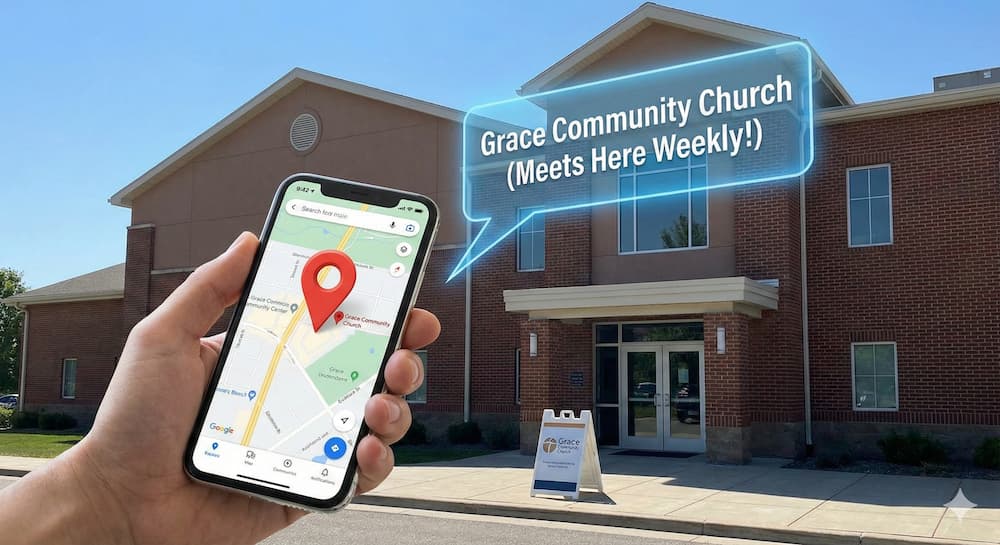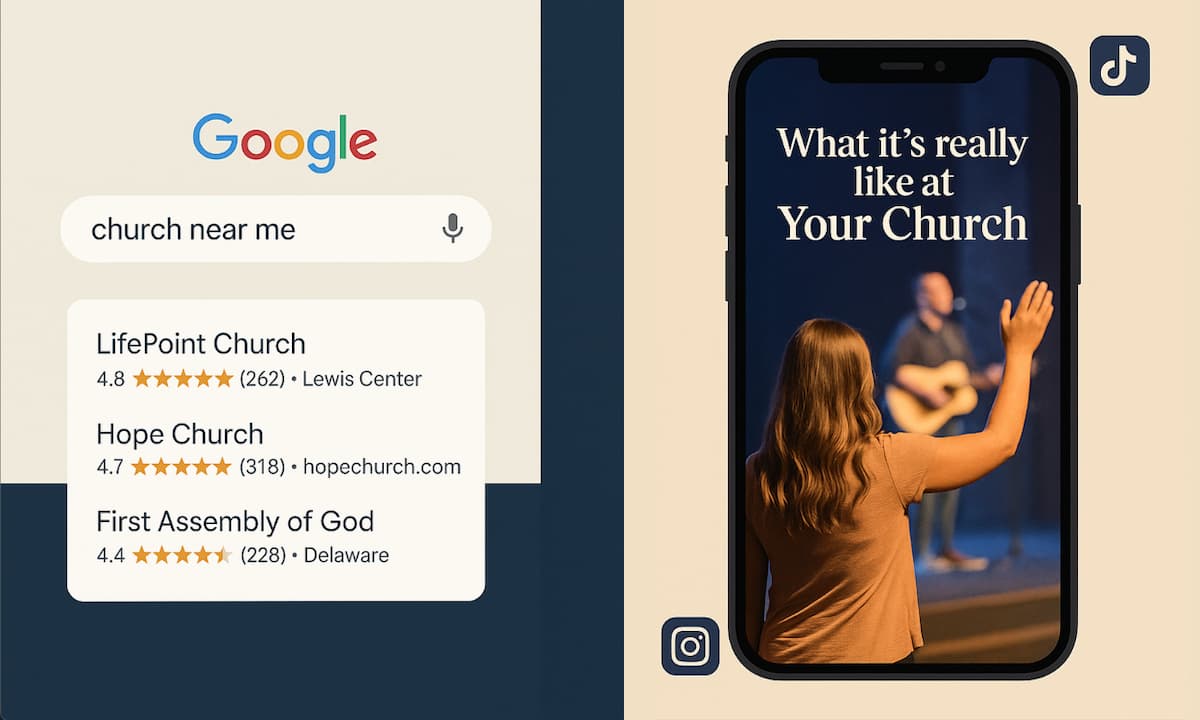How to Keep Your Church Email List From Feeling Like Junk Mail
Tired of low open rates on your church emails? Discover simple, effective strategies to make your church email list feel personal, purposeful, and never like junk mail.

How to Keep Your Emails From Feeling Like Junk Mail
If you’ve ever stared at your church’s weekly email wondering, Does anyone even read this anymore?—you’re not alone.
Maybe you’ve poured time into formatting, added the latest announcements, triple-checked the service times, and hit send… only to find that the open rate was underwhelming and nobody clicked on anything.
It’s easy for church emails to get ignored—not because people don’t care, but because their inboxes are already full. Between school updates, Amazon receipts, and everything else flooding their screens, most people are scanning emails more than they’re reading them.
That doesn’t mean church emails aren’t worth doing. But it does mean we need to be thoughtful if we want our emails to get opened—and actually make a difference.
Here are some practical ways to help your church email list feel helpful instead of spammy.
Know the purpose of your email
Before you write anything, ask yourself: What is the goal of this message?
Are you trying to:
- Keep people informed of upcoming events?
- Encourage them spiritually?
- Help them take a next step?
- Share a story from within the church?
It’s okay if your weekly email does a bit of all of those things—but it helps to lead with one main idea.
If every email tries to include everything, it starts to feel bloated and hard to follow. People tune out. And when people tune out, they stop opening altogether.
Write like a real person
Think about the last email you actually enjoyed reading. It probably didn’t start with:
“Greetings! We hope this message finds you well.”
Emails that sound like they were written by a committee rarely get read. Church emails are no exception.
Instead, write like you talk. Use contractions. Ask questions. Keep it friendly and clear.
“Hey church family—here’s what’s coming up this weekend and a quick story that’ll brighten your day.”
People respond to people. If you sound human and warm, your message is more likely to be welcomed.
Keep your subject lines simple and honest
Subject lines are where most emails live or die.
If your subject line is vague or overly “churchy,” people will likely skip over it.
Compare:
- ✖️ “Weekly Newsletter - March 3rd Edition”
- ✔️ “The 2-minute update for your weekend plans”
Or:
- ✖️ “Faith and Fellowship Updates”
- ✔️ “How one small group showed up in a big way”
You’re not trying to be clickbait—but you are trying to earn the open. Give people a reason to open your email that doesn’t feel like a chore.
Put the most important stuff at the top
Most people won’t scroll all the way down. If you bury your most important content at the bottom of your email, many won’t see it.
Use the top section of your email for the thing you really want people to know this week:
- A reminder about Easter services
- A highlight from the youth retreat
- A personal note from the pastor
Whatever you put first sends the signal: “This matters most.”
Use headers or bold text to make it easy to skim. Most people read church emails on their phones. If they can’t see what it’s about in 10 seconds or less, they’re moving on.
Use stories to make announcements feel like people, not paperwork
Rather than just listing events, include a small win or story connected to one.
For example, instead of:
“Small Group Kickoff starts next week. Sign up here.”
Try:
“Matt joined a small group last fall after moving here from out of state. It quickly became his favorite part of the week. ‘I didn’t know anyone at the church, and now I have people who pray with me and show up for me.’ If you’re looking for connection, Small Groups Kickoff starts next week. Here’s the link to sign up.”
You don’t need a full-blown story in every email—but even a quote or short sentence from a real person helps put a face to what you’re promoting.
Send it from a real person
If your emails come from “info@yourchurch.org” with a subject line like “Weekly Update,” they already look like mass mail.
Instead, try sending them from a pastor or staff member’s name and email address. Even if it’s just a first name in the “From” line, it humanizes the message.
People are more likely to open an email from “Sarah from Rock Point Church” than from “Rock Point Church Weekly Newsletter.”
Give people something worth forwarding
One of the best compliments to your email is when someone forwards it to a friend.
That happens more often when:
- You include a short story of impact
- You share a clear next step (like an invite to a community event)
- You provide a link that’s helpful beyond just your church (like a parenting seminar or free resource)
If someone feels like your email has value, they’ll naturally share it.
Review your email performance, but don’t obsess
Most email tools (like Mailchimp, Constant Contact, or even Tithely’s messaging tools) give you insight into open rates, click rates, and unsubscribes.
These numbers can help you learn what your people are actually engaging with.
If your open rate drops, check your subject lines. If your click-through rate is low, look at how you’re phrasing your calls to action.
That said—don’t obsess. You’re not running a business. You’re trying to communicate clearly with people who care about your church. If your email is helpful, respectful of their time, and consistently shows up with warmth and clarity, that’s a win.
Final Thought
Your church email doesn’t have to be perfect—but it does need to be clear, personal, and worth reading. People want to stay connected to what’s happening in your church. You just have to make it easy for them to do so.
Write with purpose. Keep it short. Lead with what matters. And always—always—write like you’re talking to real people you care about.
Sign Up for Product Updates
How to Keep Your Emails From Feeling Like Junk Mail
If you’ve ever stared at your church’s weekly email wondering, Does anyone even read this anymore?—you’re not alone.
Maybe you’ve poured time into formatting, added the latest announcements, triple-checked the service times, and hit send… only to find that the open rate was underwhelming and nobody clicked on anything.
It’s easy for church emails to get ignored—not because people don’t care, but because their inboxes are already full. Between school updates, Amazon receipts, and everything else flooding their screens, most people are scanning emails more than they’re reading them.
That doesn’t mean church emails aren’t worth doing. But it does mean we need to be thoughtful if we want our emails to get opened—and actually make a difference.
Here are some practical ways to help your church email list feel helpful instead of spammy.
Know the purpose of your email
Before you write anything, ask yourself: What is the goal of this message?
Are you trying to:
- Keep people informed of upcoming events?
- Encourage them spiritually?
- Help them take a next step?
- Share a story from within the church?
It’s okay if your weekly email does a bit of all of those things—but it helps to lead with one main idea.
If every email tries to include everything, it starts to feel bloated and hard to follow. People tune out. And when people tune out, they stop opening altogether.
Write like a real person
Think about the last email you actually enjoyed reading. It probably didn’t start with:
“Greetings! We hope this message finds you well.”
Emails that sound like they were written by a committee rarely get read. Church emails are no exception.
Instead, write like you talk. Use contractions. Ask questions. Keep it friendly and clear.
“Hey church family—here’s what’s coming up this weekend and a quick story that’ll brighten your day.”
People respond to people. If you sound human and warm, your message is more likely to be welcomed.
Keep your subject lines simple and honest
Subject lines are where most emails live or die.
If your subject line is vague or overly “churchy,” people will likely skip over it.
Compare:
- ✖️ “Weekly Newsletter - March 3rd Edition”
- ✔️ “The 2-minute update for your weekend plans”
Or:
- ✖️ “Faith and Fellowship Updates”
- ✔️ “How one small group showed up in a big way”
You’re not trying to be clickbait—but you are trying to earn the open. Give people a reason to open your email that doesn’t feel like a chore.
Put the most important stuff at the top
Most people won’t scroll all the way down. If you bury your most important content at the bottom of your email, many won’t see it.
Use the top section of your email for the thing you really want people to know this week:
- A reminder about Easter services
- A highlight from the youth retreat
- A personal note from the pastor
Whatever you put first sends the signal: “This matters most.”
Use headers or bold text to make it easy to skim. Most people read church emails on their phones. If they can’t see what it’s about in 10 seconds or less, they’re moving on.
Use stories to make announcements feel like people, not paperwork
Rather than just listing events, include a small win or story connected to one.
For example, instead of:
“Small Group Kickoff starts next week. Sign up here.”
Try:
“Matt joined a small group last fall after moving here from out of state. It quickly became his favorite part of the week. ‘I didn’t know anyone at the church, and now I have people who pray with me and show up for me.’ If you’re looking for connection, Small Groups Kickoff starts next week. Here’s the link to sign up.”
You don’t need a full-blown story in every email—but even a quote or short sentence from a real person helps put a face to what you’re promoting.
Send it from a real person
If your emails come from “info@yourchurch.org” with a subject line like “Weekly Update,” they already look like mass mail.
Instead, try sending them from a pastor or staff member’s name and email address. Even if it’s just a first name in the “From” line, it humanizes the message.
People are more likely to open an email from “Sarah from Rock Point Church” than from “Rock Point Church Weekly Newsletter.”
Give people something worth forwarding
One of the best compliments to your email is when someone forwards it to a friend.
That happens more often when:
- You include a short story of impact
- You share a clear next step (like an invite to a community event)
- You provide a link that’s helpful beyond just your church (like a parenting seminar or free resource)
If someone feels like your email has value, they’ll naturally share it.
Review your email performance, but don’t obsess
Most email tools (like Mailchimp, Constant Contact, or even Tithely’s messaging tools) give you insight into open rates, click rates, and unsubscribes.
These numbers can help you learn what your people are actually engaging with.
If your open rate drops, check your subject lines. If your click-through rate is low, look at how you’re phrasing your calls to action.
That said—don’t obsess. You’re not running a business. You’re trying to communicate clearly with people who care about your church. If your email is helpful, respectful of their time, and consistently shows up with warmth and clarity, that’s a win.
Final Thought
Your church email doesn’t have to be perfect—but it does need to be clear, personal, and worth reading. People want to stay connected to what’s happening in your church. You just have to make it easy for them to do so.
Write with purpose. Keep it short. Lead with what matters. And always—always—write like you’re talking to real people you care about.
podcast transcript
How to Keep Your Emails From Feeling Like Junk Mail
If you’ve ever stared at your church’s weekly email wondering, Does anyone even read this anymore?—you’re not alone.
Maybe you’ve poured time into formatting, added the latest announcements, triple-checked the service times, and hit send… only to find that the open rate was underwhelming and nobody clicked on anything.
It’s easy for church emails to get ignored—not because people don’t care, but because their inboxes are already full. Between school updates, Amazon receipts, and everything else flooding their screens, most people are scanning emails more than they’re reading them.
That doesn’t mean church emails aren’t worth doing. But it does mean we need to be thoughtful if we want our emails to get opened—and actually make a difference.
Here are some practical ways to help your church email list feel helpful instead of spammy.
Know the purpose of your email
Before you write anything, ask yourself: What is the goal of this message?
Are you trying to:
- Keep people informed of upcoming events?
- Encourage them spiritually?
- Help them take a next step?
- Share a story from within the church?
It’s okay if your weekly email does a bit of all of those things—but it helps to lead with one main idea.
If every email tries to include everything, it starts to feel bloated and hard to follow. People tune out. And when people tune out, they stop opening altogether.
Write like a real person
Think about the last email you actually enjoyed reading. It probably didn’t start with:
“Greetings! We hope this message finds you well.”
Emails that sound like they were written by a committee rarely get read. Church emails are no exception.
Instead, write like you talk. Use contractions. Ask questions. Keep it friendly and clear.
“Hey church family—here’s what’s coming up this weekend and a quick story that’ll brighten your day.”
People respond to people. If you sound human and warm, your message is more likely to be welcomed.
Keep your subject lines simple and honest
Subject lines are where most emails live or die.
If your subject line is vague or overly “churchy,” people will likely skip over it.
Compare:
- ✖️ “Weekly Newsletter - March 3rd Edition”
- ✔️ “The 2-minute update for your weekend plans”
Or:
- ✖️ “Faith and Fellowship Updates”
- ✔️ “How one small group showed up in a big way”
You’re not trying to be clickbait—but you are trying to earn the open. Give people a reason to open your email that doesn’t feel like a chore.
Put the most important stuff at the top
Most people won’t scroll all the way down. If you bury your most important content at the bottom of your email, many won’t see it.
Use the top section of your email for the thing you really want people to know this week:
- A reminder about Easter services
- A highlight from the youth retreat
- A personal note from the pastor
Whatever you put first sends the signal: “This matters most.”
Use headers or bold text to make it easy to skim. Most people read church emails on their phones. If they can’t see what it’s about in 10 seconds or less, they’re moving on.
Use stories to make announcements feel like people, not paperwork
Rather than just listing events, include a small win or story connected to one.
For example, instead of:
“Small Group Kickoff starts next week. Sign up here.”
Try:
“Matt joined a small group last fall after moving here from out of state. It quickly became his favorite part of the week. ‘I didn’t know anyone at the church, and now I have people who pray with me and show up for me.’ If you’re looking for connection, Small Groups Kickoff starts next week. Here’s the link to sign up.”
You don’t need a full-blown story in every email—but even a quote or short sentence from a real person helps put a face to what you’re promoting.
Send it from a real person
If your emails come from “info@yourchurch.org” with a subject line like “Weekly Update,” they already look like mass mail.
Instead, try sending them from a pastor or staff member’s name and email address. Even if it’s just a first name in the “From” line, it humanizes the message.
People are more likely to open an email from “Sarah from Rock Point Church” than from “Rock Point Church Weekly Newsletter.”
Give people something worth forwarding
One of the best compliments to your email is when someone forwards it to a friend.
That happens more often when:
- You include a short story of impact
- You share a clear next step (like an invite to a community event)
- You provide a link that’s helpful beyond just your church (like a parenting seminar or free resource)
If someone feels like your email has value, they’ll naturally share it.
Review your email performance, but don’t obsess
Most email tools (like Mailchimp, Constant Contact, or even Tithely’s messaging tools) give you insight into open rates, click rates, and unsubscribes.
These numbers can help you learn what your people are actually engaging with.
If your open rate drops, check your subject lines. If your click-through rate is low, look at how you’re phrasing your calls to action.
That said—don’t obsess. You’re not running a business. You’re trying to communicate clearly with people who care about your church. If your email is helpful, respectful of their time, and consistently shows up with warmth and clarity, that’s a win.
Final Thought
Your church email doesn’t have to be perfect—but it does need to be clear, personal, and worth reading. People want to stay connected to what’s happening in your church. You just have to make it easy for them to do so.
Write with purpose. Keep it short. Lead with what matters. And always—always—write like you’re talking to real people you care about.
VIDEO transcript
How to Keep Your Emails From Feeling Like Junk Mail
If you’ve ever stared at your church’s weekly email wondering, Does anyone even read this anymore?—you’re not alone.
Maybe you’ve poured time into formatting, added the latest announcements, triple-checked the service times, and hit send… only to find that the open rate was underwhelming and nobody clicked on anything.
It’s easy for church emails to get ignored—not because people don’t care, but because their inboxes are already full. Between school updates, Amazon receipts, and everything else flooding their screens, most people are scanning emails more than they’re reading them.
That doesn’t mean church emails aren’t worth doing. But it does mean we need to be thoughtful if we want our emails to get opened—and actually make a difference.
Here are some practical ways to help your church email list feel helpful instead of spammy.
Know the purpose of your email
Before you write anything, ask yourself: What is the goal of this message?
Are you trying to:
- Keep people informed of upcoming events?
- Encourage them spiritually?
- Help them take a next step?
- Share a story from within the church?
It’s okay if your weekly email does a bit of all of those things—but it helps to lead with one main idea.
If every email tries to include everything, it starts to feel bloated and hard to follow. People tune out. And when people tune out, they stop opening altogether.
Write like a real person
Think about the last email you actually enjoyed reading. It probably didn’t start with:
“Greetings! We hope this message finds you well.”
Emails that sound like they were written by a committee rarely get read. Church emails are no exception.
Instead, write like you talk. Use contractions. Ask questions. Keep it friendly and clear.
“Hey church family—here’s what’s coming up this weekend and a quick story that’ll brighten your day.”
People respond to people. If you sound human and warm, your message is more likely to be welcomed.
Keep your subject lines simple and honest
Subject lines are where most emails live or die.
If your subject line is vague or overly “churchy,” people will likely skip over it.
Compare:
- ✖️ “Weekly Newsletter - March 3rd Edition”
- ✔️ “The 2-minute update for your weekend plans”
Or:
- ✖️ “Faith and Fellowship Updates”
- ✔️ “How one small group showed up in a big way”
You’re not trying to be clickbait—but you are trying to earn the open. Give people a reason to open your email that doesn’t feel like a chore.
Put the most important stuff at the top
Most people won’t scroll all the way down. If you bury your most important content at the bottom of your email, many won’t see it.
Use the top section of your email for the thing you really want people to know this week:
- A reminder about Easter services
- A highlight from the youth retreat
- A personal note from the pastor
Whatever you put first sends the signal: “This matters most.”
Use headers or bold text to make it easy to skim. Most people read church emails on their phones. If they can’t see what it’s about in 10 seconds or less, they’re moving on.
Use stories to make announcements feel like people, not paperwork
Rather than just listing events, include a small win or story connected to one.
For example, instead of:
“Small Group Kickoff starts next week. Sign up here.”
Try:
“Matt joined a small group last fall after moving here from out of state. It quickly became his favorite part of the week. ‘I didn’t know anyone at the church, and now I have people who pray with me and show up for me.’ If you’re looking for connection, Small Groups Kickoff starts next week. Here’s the link to sign up.”
You don’t need a full-blown story in every email—but even a quote or short sentence from a real person helps put a face to what you’re promoting.
Send it from a real person
If your emails come from “info@yourchurch.org” with a subject line like “Weekly Update,” they already look like mass mail.
Instead, try sending them from a pastor or staff member’s name and email address. Even if it’s just a first name in the “From” line, it humanizes the message.
People are more likely to open an email from “Sarah from Rock Point Church” than from “Rock Point Church Weekly Newsletter.”
Give people something worth forwarding
One of the best compliments to your email is when someone forwards it to a friend.
That happens more often when:
- You include a short story of impact
- You share a clear next step (like an invite to a community event)
- You provide a link that’s helpful beyond just your church (like a parenting seminar or free resource)
If someone feels like your email has value, they’ll naturally share it.
Review your email performance, but don’t obsess
Most email tools (like Mailchimp, Constant Contact, or even Tithely’s messaging tools) give you insight into open rates, click rates, and unsubscribes.
These numbers can help you learn what your people are actually engaging with.
If your open rate drops, check your subject lines. If your click-through rate is low, look at how you’re phrasing your calls to action.
That said—don’t obsess. You’re not running a business. You’re trying to communicate clearly with people who care about your church. If your email is helpful, respectful of their time, and consistently shows up with warmth and clarity, that’s a win.
Final Thought
Your church email doesn’t have to be perfect—but it does need to be clear, personal, and worth reading. People want to stay connected to what’s happening in your church. You just have to make it easy for them to do so.
Write with purpose. Keep it short. Lead with what matters. And always—always—write like you’re talking to real people you care about.



























